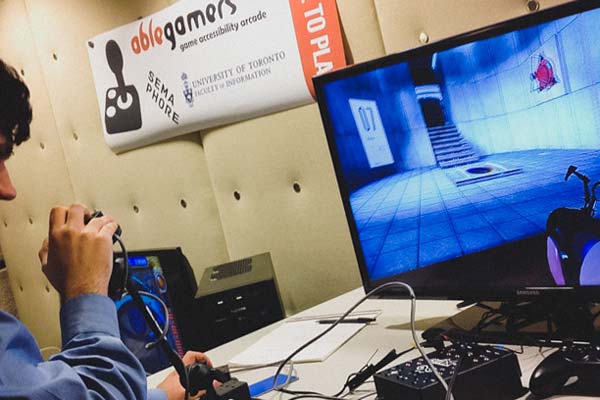
Arcade helps disabled video gamers reach the next level
Published: April 30, 2014
Thanks to heroes such as Terry Fox and Rick Hansen, physically disabled Canadians have more accessible spaces than ever before with improved building codes, automatic door entrances, and ramps in the real world. And yet, the disabled are often prevented from experiencing life in the virtual worlds of video games.
But with help from the technologies featured at a newly launched 'Accessiblity Arcade' at the University of Toronto, a more fully accessible virtual reality may be closer than ever.
“This arcade can help discover and explore various adaptive technologies for disabled gamers," said Dr. Sara Grimes, assistant professor at the Faculty of Information and Associate Director of the Semaphore Research Cluster. “It can also act as a place for thinking about additional ways to make digital play even more inclusive - from DIY solutions to altering standard industry practices.”
The first Canadian AbleGamers Accessibility Arcade is a permanent installation in Robarts Library that includes the most up-to-date technology and controllers to enable those with disabilities to access popular video games. It was launched in late April by The Semaphore Research Cluster at the University of Toronto’s Faculty of Information. (Read more about Semaphore and the accessibility arcade)
The arcade features a range of devices to accommodate the needs of gamers with disabilities, from mouth-controlled devices to others that can accommodate players with tremors and highly-sensitive controllers for those with limited range of motion in the hands. (Read more about the devices in a Globe and Mail feature on the arcade)
The arcade is a partnership between AbleGamers, a U.S. non-profit dedicated to improving the quality of life for people with disabilities through digital entertainment, and the Sempahore Research Cluster which explores the uses of mobile and ubiquitous computer technology.
“I think that the event was just the start. Looking at the capabilities Semaphore has at their disposal, I know the students are going to build on this in ways I cannot even dream,” said Mark Barlet, Founder and Executive Director of the AbleGamers Charity at the arcade’s launch.
“All gamers with disabilities are going to benefit from this,” said Grimes.
“My hope in bringing AbleGamers and Semaphore together is that the arcade will be used as a hub for critical discussion, research and innovation relating to identifying and overcoming accessibility and design limitations found in digital games and gaming technologies,” she added.
The arcade is permanently open to the public by appointment. For more information, contact the Semaphore Research Cluster coordinator at 416-978-0891 or by emailing amy.ratelle@utoronto.ca.
Amy Ratelle is a writer with the Semaphore Research Cluster.


